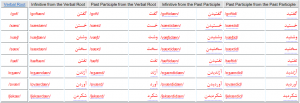Dental suffixes are a group of suffixes in Indo-European Languages which begin with a dental or alveolar consonant (mostly /t/, /d/ or /ð/) and are applied in the derivation from verbal roots.
The following dental suffixes can be found in Persian:
- The dental suffix /-t/, for the derivation of past participles: /sɒxt/ ساخت، /sereʃt/ سرشت
- The dental suffix /-tæn/, for the derivation of infinitives: /ændɒxtæn/ انداختن, /ænbɒʃtæn/ انباشتن
- The dental suffix /-tɒr/ is applied in relatively few affixal formations:
- Nomen actionis: /goftɒr/ گفتار
- Nomen patientis: /gereftɒr/ گرفتار
- Simple nomen agentis: /xɒstɒr/ خواستار
In addition to verbal roots, present (and very occasionally past participles) can also be applied as stems of dental suffixes (see below).
The following notes can be remarked regarding dental suffixes:
- In Persian, the voiceless consonant /t/ of dental suffixes becomes sonorized to /d/ after voiced consonants in addition to after vowels(see 1•d•c.). Thereby, the allomorphs [-d], [-dæn] and [-dɒr] are generated:
زد /zæd/، آماد /ɒmɒd/، شد /ʃod/، سود /sud/
کندن /kændæn/، آماردن /ɒmɒrdæn/، آژدن /ɒʒdæn/، آمیغدن /ɒmiɣdæn/
کردار /kærdɒr/، دیدار /didɒr/
In archaic Persian (until the Mongolian era), the phoneme /d/ د generally appeared after vowels in the form of the allophone [ð] ذ (see 1•b•a. Combinative Variation): /zæð/ زذ, /ʃoð/ شذ, /diðɒr/ دیذار
- Epentheses are not used for derivation from verbal roots. This feature can be used to differentiate between derivates of verbal roots and present participles.
The following epentheses are used with dental suffixes:
- There is no phonetic limit to use the epenthesis /i/. Therefore, it is the most applied epenthesis with these suffixes:
بافت، بافید /bɒft/ (/bɒfid/)، نازید /nɒzid/
گساردن، گساریدن /gosɒrdæn/ (/gosɒridæn/)، پریدن /pæridæn/
خریدار /xæridɒr/
- The epenthesis /ɒ/ is only noted after the consonants /h/, /t/ and /d/:
رهاد /ræhɒd/، ایستاد /istɒd/
نهادن /nehɒdæn/، فرستادن /ferestɒdæn/، دادن /dɒdæn/
- The epenthesis /s/ can appear as the following allomorphs:
- As the allophone [s] after vowels:
آراست /ɒrɒst/، زیست /zist/
نشاستن /neʃɒstæn/، ریستن /ristan/
If the present participle ends with the vowel /u/, this vowel must be assimilated into [o]:
/ʃu/ + dental suffix /-t/ → /ʃost/ شست
/ʤu/ + dental suffix /-tæn/ → /ʤostæn/ جستن
/ru/ + dental suffix /-tæn/ → /rostæn/ رستن
In front of epenthesis, the consonant /h/ must be elided from the final phoneme string /ɒh/, /æh/ and /ih/:
/ʤæh/ + dental suffix /-t/ → /ʤæst/ جست
/kɒh/ + dental suffix /-t/ → /kɒst/ کاست
/ʤih/ + dental suffix /-tæn/ → /ʤistæn/ جیستن
- As the allophone [es] after consonants:
/neh/ + dental suffix /-t/ → /nehest/ نهست
/dɒn/ + dental suffix /-tæn/ → /dɒnestæn/ دانستن
/jɒr/ + dental suffix /-tæn/ → /jɒrestæn/ یارستن
- After the consonant /r/, the allophone [is] can be also applied:
/negær/ + dental suffix /-tæn/ → /negæristæn/ نگریستن
- As the allophone [s] after vowels:
- The epenthesis /e/ appears (like in all other cases, see 1•d•a.) to avoid the following constellations:
- c1c2c3
- vc1c2, whereas v represents one of the long vowels /ɒ/, /i/ or /u/.
/fæxm/ + dental suffix /-tæn/ → /fæxmedæn/ فخمدن
/jɒz/ + dental suffix /-tæn/ → /jɒzedæn/ یازدن
/ɒʤ/ + dental suffix /-tæn/ → /ɒʤdæn/ (/ɒʤedæn/) آجدن
- There is no phonetic limit to use the epenthesis /i/. Therefore, it is the most applied epenthesis with these suffixes:
- If present participles are generated by mutation (and thus are not identical to the verbal roots), derivates can be created in two lines:

According to the phonetical analogy (the reducing of word forms being perceived as irregular by remaking them in the shape of more common forms) in the Persian language change, the tendency to derivate infinitives and past participles from present participles (with the epenthesis /i/) is cognizable, and the derivation from verbal roots is eclipsing.
- The derivation of infinitives and past participles from other past participles is very rare. This process is only noted with mono- (or occasionally disyllabic) past participles (always with the epenthesis /i/):

- The variation in stems of the dental suffixes is frequently noted in Persian: they can be alternated by exchanging the long vowels with their allophones:
- /ɒ/ → [æ]
- /i/ → [e]
- /u/ → [o]
This variation can be classified as follows:
- Replacing the initial vowel /ɒ/ with [æ] by means of free variation:
/ɒbeʃtæn/ آبشتن → [æbeʃtæn] ابشتن
/ɒværdidæn/ آوردیدن → [æværdidæn] اوردیدن
/ɒrestæn/ آرستن → [ærestæn] ارستن
/ɒrɣidæn/ آرغیدن → [ærɣidæn] ارغیدن
/ɒzdæn/ آزدن → [æzdæn] ازدن
- Replacing the long vowels with short vowels in front of voiceless fricative consonants (in Persian /f/, /s/, /ʃ/, /x/ and /h/) by means of combinative variation:
/ɒʃuftæn/ آشوفتن → [ɒʃoftæn] آشفتن
/feriftæn/ فریفتن → [fereftæn] فرفتن
/ɒrɒstæn/ آراستن → [ɒræstæn] آرستن
/riʃtæn/ ریشتن → [reʃtæn] رشتن
/ɒvixtæn/ آویختن → [ɒvextæn] آوختن
/duxtæn/ دوختن → [doxtæn] دختن
/estihidæn/ استیهیدن → [estehidæn] استهیدن
- Replacing the long vowels with short vowels in front of voiced alveolar consonants (in Persian: /d/, /n/, /r/, /z/ and /l/) by means of combinative variation:
/ʃenudæn/ شنودن → [ʃenodæn] شندن
/ævɒnidæn/ اوانیدن → [ævænidæn] اونیدن
/ɒʃurdæn/ آشوردن → [ɒʃordæn] آشردن
/ænbɒridæn/ انباریدن → [ænbæridæn] انبریدن
/setizidæn/ ستیزیدن → [setezidæn] ستزیدن
/bæxʧizidæn/ بخچیزیدن → [bæxʧezidæn] بخچزیدن
/pɒlidæn/ پالیدن → [pælidæn] پلیدن
- Other variation patterns are unusual, and are only used owing to metrical conformation:
/ɒʃɒmidæn/ آشامیدن → [ɒʃæmidæn] آشمیدن
/feribidæn/ فریبیدن → [ferebidæn] فربیدن


